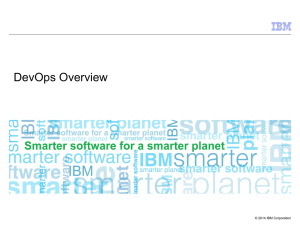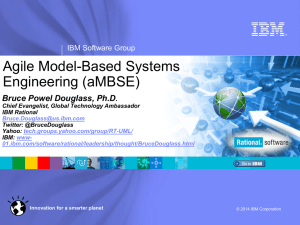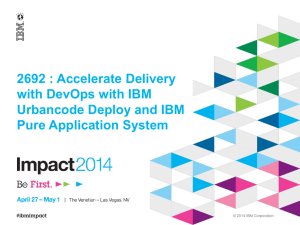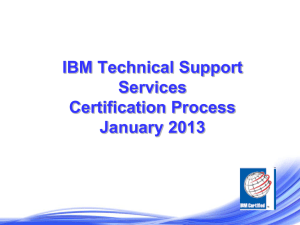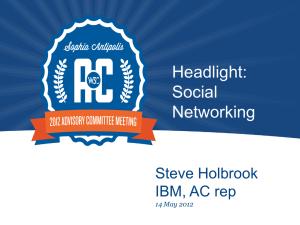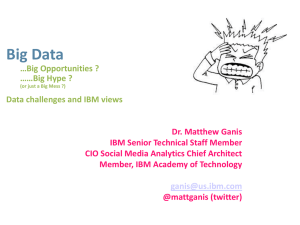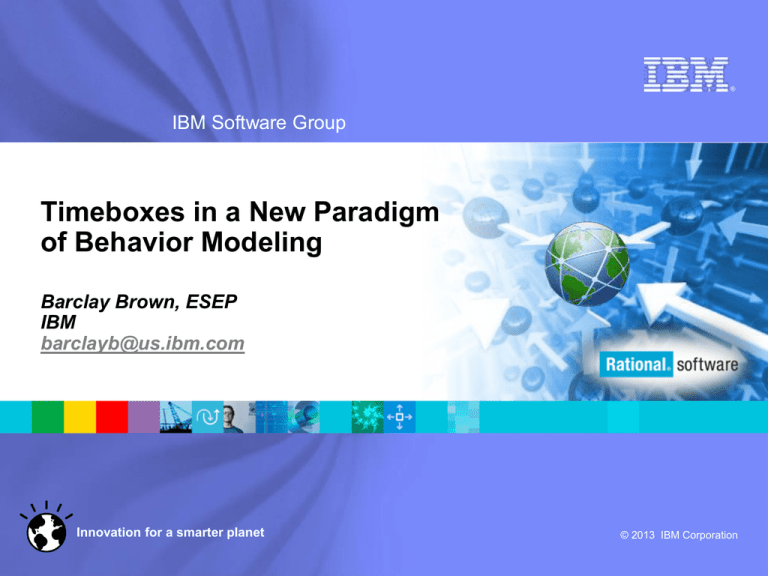
®
IBM Software Group
Timeboxes in a New Paradigm
of Behavior Modeling
Barclay Brown, ESEP
IBM
barclayb@us.ibm.com
Innovation for a smarter planet
© 2013 IBM Corporation
IBM Software Group | Rational software
Behavior
Behavior of organizations and systems is modeled in various ways
Behavior refers to the activities of organizations and technological
systems, and their interactions
What is referred to as behavior here has also been described as:
Organizational behavior
Business processes
System functional flow
Organization
System
Activity Flow
Task procedures
Organization
Use case flow of events
Operational scenarios
Concept of Operations (CONOPS)
Innovation for a smarter planet
System
IBM Software Group | Rational software
Two Paradigms
Two primary paradigms, the process paradigm and the
systems paradigm.
Process paradigm: behavior is described in processes, which
consist of sequences of activities.
Systems paradigm, behavior is described as sequences of activities
and interactions between systems, sub-systems and users, in order
to achieve a user goal.
New
Energy
Policy
Process
Claim
Form
Detect
Target
Order a
Book
Online
Brighten
Screen in
Sunlight
Levels of
Abstraction
Innovation for a smarter planet
IBM Software Group | Rational software
A Personal Example
A complex system
Complex system interaction
How to model a life?
Processes?
A day in the life
Career, family, hobby processes?
Use Cases?
Innovation for a smarter planet
Complex systems using technology
“The unexamined
[unmodeled?] life is
not worth living”
- Socrates
IBM Software Group | Rational software
Key Concept:
Time and Sequence
The key to untangling and understanding
complex processes is the representation of
time.
Time = Past + Present + Future
The past looks linear, like a timeline
The present looks simultaneous, like a process
The future looks timeboxed, like a plan
Innovation for a smarter planet
IBM Software Group | Rational software
Past, Present and Future
PRESENT
TIMELINE
Past events are easy to see on a linear timeline (we know when they
happened)
A process can be seen as happening now, in the present (but of
course this isn’t really true—the present is of infinitesimally short
duration, so nothing actually happens in the present)
The future really contains processes contained in timeboxes
Innovation for a smarter planet
IBM Software Group | Rational software
An Example:
he Heart’s Past,
Present and Future
PAST
FUTURE
PRESENT
Innovation for a smarter planet
IBM Software Group | Rational software
Timelines: A natural view of time
http://www.scientificamerican.com/article/space-shuttle-retirement-timeline/
Innovation for a smarter planet
IBM Software Group | Rational software
Timeboxes
• Boxes of time
• Have start time, end time and duration
– Any or all of these may be unknown
• All start/end dates/times are ranges
– 11/11/13 means the 24 hour period starting at midnight
– 3:05pm means the 60 second period starting 3:05:00 (or
3:04:31?)
– Q2 means the 90 day period beginning April 1.
• Durations ideally also include uncertainty
–
–
–
–
Best case: 2 hours
Worst case: 5 hours
Most likely case: 3 hours
Triangular distribution used to express estimates
• Actual outcome has skewed distribution (more often late then early)
• Timeboxes “connect” to each other only in time
Innovation for a smarter planet
IBM Software Group | Rational software
Timebox Examples
Implement Interface by Friday
RFP Response Q2-Q3
2-4 hours
Q2
July 1,
00:00:00
Sep 30,
23:59:59
Q3
?
Friday
Timeboxes on a timeline
Innovation for a smarter planet
IBM Software Group | Rational software
Timeboxes with Timelines Examples (cont’d)
Innovation for a smarter planet
IBM Software Group | Rational software
Ongoing Processes
ABSTRACT TIMELINE
Indeterminate start, end and duration
Shows relative time positioning
Allows for zooming in and out in modeling tools
Innovation for a smarter planet
IBM Software Group | Rational software
Nesting/Recursion in Timeboxes
A timebox may contain other timeboxes
A timebox may contain a timeline or not.
If a timebox does contain a timeline, the timeline must synchronize with all other timelines
If it does not, then contained timeboxes are simply grouped and assumed to all occur
within the interval of the containing timebox.
Innovation for a smarter planet
IBM Software Group | Rational software
Benefits of Timeboxes in Behaviour modelling
Processes can be shown in relation to the passage of time, without committing
individual process elements to specific points in time.
Iterative and conditional process flows can be shown where they are planned to
occur in time, without reducing them to a series of specific events and activities.
Processes can be shown as related to each other in time without implying
causal relationships and direct connections.
The difference between past, present and future events and activities, is
incorporated in a single model. Planned (future) activities flow seamlessly into the
past as uncertainty is eliminated.
Enough information about the uncertainty of timing is included that overall
behavioural models can be constructed and simulated using Monte Carlo and
other simulation techniques.
Variable precision--start, end and duration times can be expressed in scales of
seconds, minutes, days, months or years. (Zooming in and out in time can be
automated in graphical tools.)
Innovation for a smarter planet
Software and Systems Engineering | Rational
Learn more at:
IBM Rational software
IBM Rational Software Delivery Platform
Process and portfolio management
Change and release management
Quality management
Architecture management
Rational trial downloads
Leading Innovation Web site
developerWorks Rational
IBM Rational TV
IBM Business Partners
IBM Rational Case Studies
© Copyright IBM Corporation 2008. All rights reserved. The information contained in these materials is provided for informational purposes only, and is provided AS IS without warranty of any kind, express or implied.
IBM shall not be responsible for any damages arising out of the use of, or otherwise related to, these materials. Nothing contained in these materials is intended to, nor shall have the effect of, creating any warranties
or representations from IBM or its suppliers or licensors, or altering the terms and conditions of the applicable license agreement governing the use of IBM software. References in these materials to IBM products, programs,
or services do not imply that they will be available in all countries in which IBM operates. Product release dates and/or capabilities referenced in these materials may change at any time at IBM’s sole discretion based on
market opportunities or other factors, and are not intended to be a commitment to future product or feature availability in any way. IBM, the IBM logo, Rational, the Rational logo, and other IBM products and services are
trademarks of the International Business Machines Corporation, in the United States, other countries or both. Other company, product, or service names may be trademarks or service marks of others.
© 2011 IBM Corporation
Software and Systems Engineering | Rational
Copyright information
© Copyright IBM Corporation 2011
IBM Corporation
Software Group
Route 100
Somers, NY 10589
Produced in the United States of America
03-07
All Rights Reserved.
Build Forge, ClearCase, ClearQuest, IBM, the IBM logo, PurifyPlus, Rational, Rational Rose, Rational Test RealTime, Rational Unified
Process, RUP, SoDA, XDE and WebSphere are trademarks or registered trademarks of International Business Machines Corporation in the
United States, other countries or both.
Java and all Java-based trademarks are trademarks of Sun Microsystems, Inc. in the United States, other countries, or both.
Microsoft is a trademark of Microsoft Corporation in the United States, other countries, or both.
Other company, product and service names may be trademarks or registered trademarks or service marks of others.
The information contained in this documentation is provided for informational purposes only. While efforts were made to verify the
completeness and accuracy of the information contained in this documentation, it is provided “as is” without warranty of any kind, express or
implied. In addition, this information is based on IBM’s current product plans and strategy, which are subject to change by IBM without
notice. IBM shall not be responsible for any damages arising out of the use of, or otherwise related to, this documentation or any other
documentation. Nothing contained in this documentation is intended to, nor shall have the effect of, creating any warranties or
representations from IBM (or its suppliers or licensors), or altering the terms and conditions of the applicable license agreement governing
the use of IBM software.
16
© 2011 IBM Corporation


